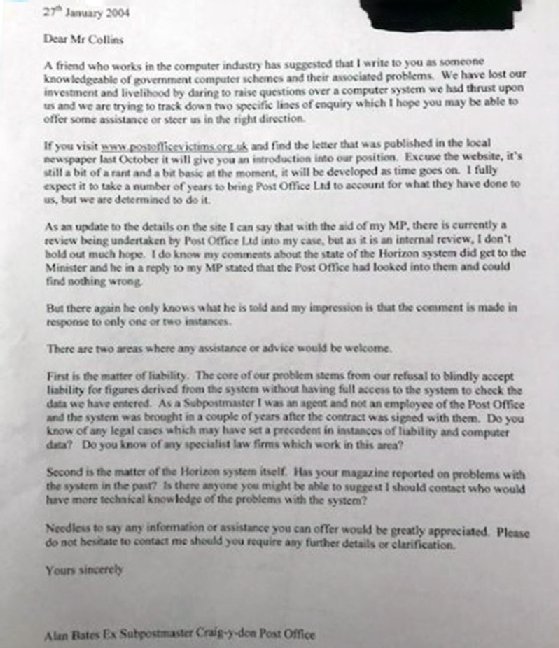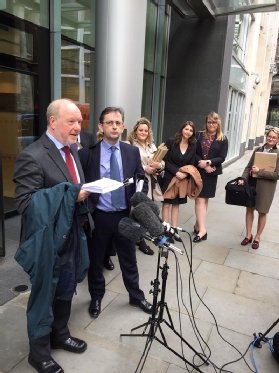Tech News
Post Office Horizon scandal explained: Everything you need to know

It has been over 20 years since the Post Office Horizon scandal first came to light, and it has now become a major news story. Computer Weekly has been instrumental in uncovering what has been described as the most significant miscarriage of justice in UK history.
In 1999, the UK government, as the sole shareholder of the Post Office, implemented an automated accounting system at around 14,000 branches. This involved the introduction of a centralised computer system from Fujitsu, connecting all branches. This system replaced the traditional paper-based accounting methods.
However, issues arose, leading to a surge in unexplained accounting discrepancies for subpostmasters. Instead of addressing the problems and rectifying them, the Post Office placed the blame on the branch operators. Many of them were prosecuted for financial crimes, resulting in bankruptcy and dismissal for many.
What is the Horizon system?
The Horizon software was originally developed by ICL, a UK software company that was later acquired by Fujitsu in 1998. The system includes an electronic point of sale service (EPOSS) that allows subpostmasters and branch workers to input sales on a touchscreen, with automated accounts in the background. When it was rolled out in 1999/2000, it was the largest non-military IT project in Europe.
What problems were caused by the system?
Shortly after the implementation of Horizon at Post Office branches, there was a noticeable increase in the number of subpostmasters experiencing unexplained accounting shortfalls. Many of them had never encountered such issues before. Under the previous paper-based system, they could trace back and identify the cause of discrepancies, but this was no longer possible with the new system.
Despite the technological advancements, the contractual agreement between the Post Office and subpostmasters remained unchanged. It stated that any accounting discrepancies were the responsibility of the subpostmasters unless proven otherwise. However, without the paper trail from the previous accounting methods, proving innocence became extremely challenging for many.
Who was affected?
Subpostmasters have a contractual agreement with the Post Office to operate branches, although they are not employees of the Post Office. These individuals typically run retail businesses alongside the Post Office operations, with the aim of attracting more customers through the Post Office services. Additionally, there are Crown branches owned by the Post Office, which have appointed branch managers.
How were subpostmasters affected?
Over a span of 15 years following the Horizon rollout, the Post Office, equipped with private investigation and prosecution powers, prosecuted over 700 subpostmasters for offenses such as theft and false accounting. Many subpostmasters were imprisoned, while others faced penalties like community service and electronic tagging. Countless individuals were driven to bankruptcy, losing their source of income, and many faced financial burdens as they were forced to repay non-existent shortfalls attributed to the Horizon system. The repercussions of the scandal had severe impacts on the lives and well-being of the victims and their families, with several cases of suicide and illnesses caused by stress.
How did the Post Office keep a lid on this for so long?
The Post Office made deliberate efforts to conceal the issues related to the Horizon system. Staff in the call center, the initial point of contact for subpostmasters experiencing problems, were instructed to claim that these issues were isolated incidents. The Post Office also utilized its legal resources and financial resources to defend against allegations, even in court. The organization actively silenced subpostmasters from speaking out against the system, and misled journalists, politicians, and others questioning the system’s integrity.
How the Post Office used fear to deter subpostmasters from challenging Horizon
The Post Office employed criminal and civil legal actions to intimidate subpostmasters into silence. Subpostmasters who persisted in raising concerns about the system faced obstacles created by the Post Office to prevent wider awareness among branch operators. For instance, if a subpostmaster blamed Horizon for discrepancies and sought IT expertise, the Post Office often backed down. In cases where subpostmasters challenged the system in court, the Post Office resorted to heavy legal costs to suppress them, resulting in bankruptcies and severe personal consequences.
The Post Office also resorted to imprisoning individuals to set an example. Former subpostmaster Seema Misra was prosecuted and incarcerated based on Horizon system evidence. After her conviction, a senior Post Office official celebrated the outcome, implying that it would deter others from criticizing the Horizon system.
What was Computer Weekly’s role in exposing the scandal?
Computer Weekly was the first to report on the challenges faced by subpostmasters due to the Horizon system. In 2004, Alan Bates, a subpostmaster from north Wales, contacted Computer Weekly regarding unexplained shortfalls he attributed to Horizon errors.

In 2008, Lee Castleton also reached out to Computer Weekly with a similar story, prompting a broader investigation. Computer Weekly then published an article in 2009 detailing the experiences of seven subpostmasters facing losses, encouraging others to speak out against the Post Office’s false claims.
Who is Alan Bates?
In 1998, Alan Bates and Suzanne Sercombe purchased a Post Office branch in Craig-y-Don, north Wales, with the intention of balancing work and personal pursuits. Following the implementation of the Horizon system in 2000, Bates encountered unexplained losses and refused to sign off on accounts, attributing the discrepancies to computer errors. Despite the Post Office’s pressure, Bates stood his ground, leading to the termination of his contract, resulting in financial losses and personal setbacks.
Bates continued to advocate for subpostmasters by creating a website to connect with others facing similar challenges and engaging in campaigns to raise awareness about the Post Office scandal.

What is the Justice for Subpostmasters Alliance?
The Justice for Subpostmasters Alliance (JFSA) was established by subpostmasters who had encountered similar challenges with the Post Office’s Horizon system. The alliance aimed to provide support and advocate for the rights of subpostmasters facing unjust treatment. It organized meetings and campaigns to raise awareness and seek justice for the affected individuals.
Why did MPs get involved?
MPs, including Kevan Jones and James Arbuthnot, became involved in advocating for subpostmasters after learning about the injustices they faced. Jones’ constituent, Jo Hamilton, was wrongfully prosecuted by the Post Office, leading him to take action. The MPs played a crucial role in bringing attention to the Post Office scandal and supporting the affected individuals in seeking justice.
What was the mediation scheme and Second Sight investigation?
In response to mounting pressure, the Post Office initiated an external review and mediation scheme in 2012 to address subpostmasters’ concerns regarding the Horizon system. The Post Office enlisted the help of forensic accountancy firm Second Sight to investigate the cases. However, the investigation revealed significant issues with the system, contradicting the Post Office’s claims of its reliability.
Second Sight’s interim report in 2013 raised serious doubts about the Horizon system, leading to further scrutiny and revelations about its flaws.
Why did the Post Office end the mediation scheme and stop Second Sight’s investigation?
In March 2015, just before the release of Second Sight’s final report, the Post Office abruptly terminated the mediation scheme and halted the investigation. The decision came as Second Sight was uncovering damning evidence of potential miscarriages of justice in the Post Office prosecutions. The Post Office’s actions demonstrated a reluctance to address the systemic issues and led to further legal challenges by the affected subpostmasters.
What was the Bates and others versus Post Office High Court group litigation order?
In response to the Post Office scandal, the Justice for Subpostmasters Alliance pursued a group litigation order through the High Court, involving hundreds of victims seeking restitution for the harm caused by the Horizon system. The litigation involved multiple claimants with similar grievances against the Post Office, resulting in a landmark legal battle.
The High Court approved the group litigation order in January 2017, leading to a series of trials that exposed the truth about the Horizon system’s shortcomings. The Post Office eventually settled with the claimants, acknowledging the errors in the system and providing compensation to the affected individuals.
Why is the Post Office scandal seen as the widest miscarriage of justice in UK history?
The Post Office scandal has garnered significant attention due to the magnitude of the injustices inflicted on subpostmasters. The overturning of wrongful convictions based on Horizon evidence, along with the acknowledgment of systemic failures, highlighted the severity of the miscarriage of justice. The government’s commitment to addressing the issue through emergency legislation and compensation signifies the unprecedented scale of the scandal.

Why is compensation for subpostmasters still an ongoing injustice?
Despite the High Court judgment and the passage of several years, many subpostmasters have yet to receive the compensation owed to them. The Post Office’s slow progress in disbursing compensation, coupled with the financial struggles of many affected individuals, has prolonged the injustice. Tragically, some subpostmasters have passed away before receiving the restitution they deserve.
What is the statutory public inquiry?
In May 2021, following the High Court ruling, a government inquiry into the Post Office scandal was formally established as a statutory public inquiry. Chaired by former judge Wyn Williams, the inquiry is structured into multiple phases to investigate various aspects of the scandal. These phases include examining the human impact, the Horizon system, operational practices, and legal actions against subpostmasters.

What has the public inquiry exposed?
The public inquiry has shed light on the extensive suffering endured by individuals at the hands of the Post Office, revealing the profound impacts of the scandal. Various phases of the inquiry have exposed the Post Office’s knowledge of system flaws, witness
-

 Destination4 months ago
Destination4 months agoSingapore Airlines CEO set to join board of Air India, BA News, BA
-

 Tech News7 months ago
Tech News7 months agoBangladeshi police agents accused of selling citizens’ personal information on Telegram
-

 Motivation7 months ago
Motivation7 months agoThe Top 20 Motivational Instagram Accounts to Follow (2024)
-

 Guides & Tips6 months ago
Guides & Tips6 months agoSatisfy Your Meat and BBQ Cravings While in Texas
-

 Guides & Tips5 months ago
Guides & Tips5 months agoHave Unlimited Korean Food at MANY Unlimited Topokki!
-

 Tech News6 months ago
Tech News6 months agoSoccer team’s drone at center of Paris Olympics spying scandal
-

 Gaming5 months ago
Gaming5 months agoThe Criterion Collection announces November 2024 releases, Seven Samurai 4K and more
-

 Self Development7 months ago
Self Development7 months agoDon’t Waste Your Time in Anger, Regrets, Worries and Grudges
























